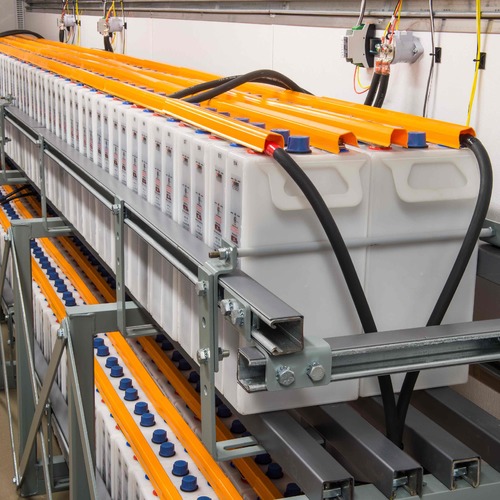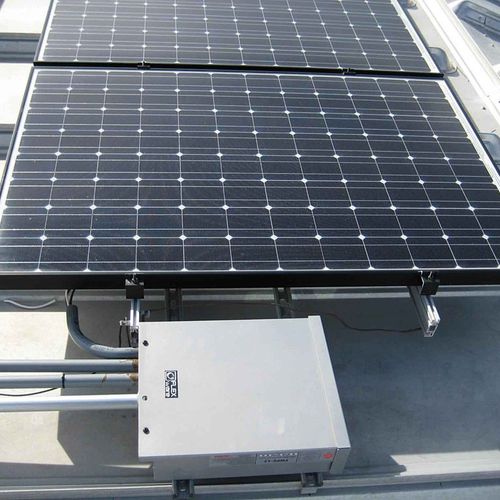Image Credit: Peter Fairley
Image Credit: Peter Fairley On the Hawaiian island of Kauai, utility-scale PV arrays can meet much of the electrical load on some days. But utility engineers have grappled with a battery storage system that didn't meet expectations. They hope these new lithium-ion batteries will solve the problem.
Image Credit: Peter Fairley
The electric utility serving the Hawaiian island of Kauai is well on its way to replacing generating stations running on fossil fuels with utility-scale photovoltaic (PV) arrays that can handle a substantial part of the utility’s peak electrical load.
The utility is in the process of completing a pair of 12-megawatt PV facilities at Anahola. When the second one is finished later this year, the facility will account for a sizable portion of the island’s total 78 MW peak power supply. On some days, the island’s solar arrays will meet 80 percent of the total load.
It’s an enviable achievement for renewable energy. But as Peter Fairley writes in a post at the MIT Technology Review, the Kauai Island Utility Cooperative has learned that progress doesn’t come without some growing pains.
The problem, Fairley explains, has been with the batteries that the utility installed to even out fluctuations in PV output. Current can drop by as much as 80 percent in less than a minute when clouds drift over the array, causing a variety of problems on the grid.
The utility invested in lead-acid batteries, building a $2 million facility designed by Xtreme Power at a 6-MW solar facility that opened in 2012 at Port Allen. The batteries were capable of releasing 4.5 MW of electricity in short bursts, and the utility hoped they would eliminate some of the problems associated with lapses in power. That included a drop in the frequency of the alternating current on the grid to below the 60 hertz standard, a problem called “frequency droop,” which could damage electrical equipment belonging to customers.
But the batteries degraded much faster than the utility had hoped. While they had been designed to last eight years, Fairley writes, they had very little capacity after just two years.
Lithium-ion batteries in a redesigned storage system
Although the utility might have tweaked the lead-acid batteries for somewhat better performance, other Xtreme customers were having problems, too, and the Texas-based company eventually declared bankruptcy.
So the utility switched gears and chose a lithium-ion battery system manufactured by SAFT, a French company, Fairley says. The new batteries should be able to handle four to six times as many charge-discharge cycles as the lead-acid batteries, and the $7 million battery installation will be able to deliver 6 MW of power continuously and 12 MW in short bursts.
The utility hopes that the increased capacity of the batteries will help ease the frequency drooping from the island’s other solar farms. Finally, when the PV facility at Anahola comes on line later in the year, there are times when solar output will exceed what the grid can carry. The batteries should be able to absorb some of the excess and distribute it at night.
A major Hawaiian utility alters its net metering rules
Elsewhere in the islands, the state’s biggest utility, the Hawaiian Electric Companies (HECO), has proposed abandoning its existing net metering program by April and replacing it with a tariff system based on the wholesale cost of electricity.
As reported at Greentech Media, the proposal to the Hawaii Public Utilities Commission this week is a way of transitioning to a new distributed generation program by 2017. By then, HECO promises a system that employs smart inverters, energy storage, and other technologies and makes it possible for customers to make money from renewable energy systems.
In the meantime, solar advocates probably won’t like what they hear.
During this transitional period, HECO proposes to pay customers who sell excess power to the grid a rate based on the wholesale cost of utility power. According to Greentech Media, the credit would be calculated as the sum of the Base Fuel Energy Charge, which is taken from the price of fuel, and the Energy Cost Adjustment rate, which lets each island to modify the base charge due to changes in fuel costs and the price of electricity it has to buy from independents.
This month, those credits would add up to about half the island’s average retail electricity costs, which range from 31.2 cents to 37.7 cents per kilowatt hour, the highest in the country.
Even with the reduction in payments, HECO said, the proposed credits should be high enough to pay off a 5-kW photovoltaic system in five to nine years.
HECO says that its net-metering payments have grown from about $19 million at the end of 2012 to $53 million by the end of last year. It claims that the existing net-metering rules force more costs onto non-solar customers, and makes the state less attractive for utility-scale and community-owned solar and geothermal projects, Greentech Media said.
The utility is concerned that the relatively high percentage of distributed generation — more than 15 percent on some circuits — causes a variety of problems on the grid. It has been working with the National Renewable Energy Laboratory and SolarCity on research aimed at showing how programmable inverters will be able to relieve some of the problems.
Weekly Newsletter
Get building science and energy efficiency advice, plus special offers, in your inbox.
















4 Comments
Lessons from off-grid homes...
Scott,
Thanks for a great story. It sounds like the utility in Kauai learned a lesson the hard way -- the same lesson that many off-grid homeowners learned a long time ago: when you push lead-acid batteries hard, they won't last the 8 years that you hoped they'd last. Pushing batteries hard makes them die early.
They also learned that you
They also learned that you can't pay a retail price for a wholesale commodity.
Hawaii Solar
Hawaii will make solar work. It has to work. At 30+ cents per kwh there's plenty of incentive. Eventually, the market will determine a reasonable price algorithm for electricity supplied to the grid (the 'wholesale commodity'). And, if batteries are needed to make solar-to-grid work, that technology will develop too.
Thanks, Scott, for the update. I'd also be interested in more on "current can drop by as much as 80% in less than a minute when clouds drift over the array, CAUSING A VARIETY OF PROBLEMS ON THE GRID". Does this suggest the 'ideal' grid would have multiple sourcing types?
Grid Defection
"Grid defection" are two little words that make utility ceo's have nightmares. Utilities are that gray fog in the background of your life... most people don't want to know about it. Off-grid types get to know a lot about running a mini-grid. It's not rocket science, but in the hands of large corporations and unions it can become "racket science". Hawaii's electricity rates at 33 cents kwh can easily be competed with by going off grid with solar and storage...especially with the new lifepo4 battery banks that are available (see Balqon store for nicely packaged reasonably priced lithium battery banks designed for off grid PV) Germany installed about 10,000 units of grid tied lifepo4 battery banks from Bosch and Saft, in solar PV residences because it competes with German rates. In the end "behind the meter" battery and solar may work better than expensive warehouses full of lithium batteries and staff trying to manage the crazy electric dragon of the centralized grid. Stay tuned for the little refrigerator of lifepo4 batteries that will soon be sitting in your basement!
Log in or create an account to post a comment.
Sign up Log in